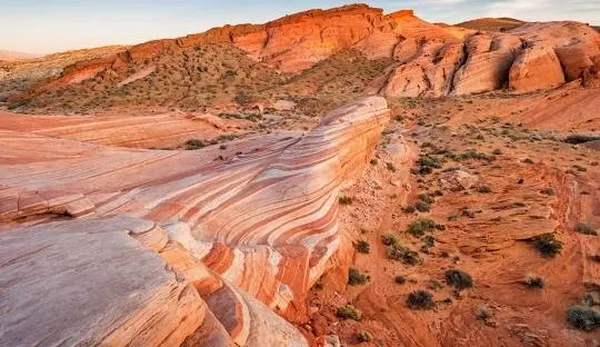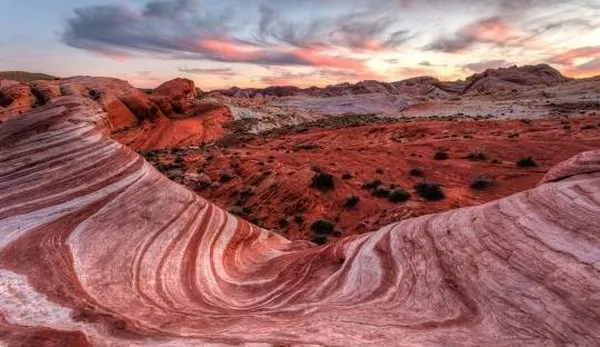Nevada, a land of vast deserts and magnificent landscapes, is not only famous for the dazzling Las Vegas but also a treasure trove of natural wonders. Among these, the diverse and unique world of cacti in Valley of Fire State Park is a must-visit destination for those who love exploring wild beauty. Join us on a journey to discover rare cacti, the resilient “warriors” of the Nevada desert.
Valley of Fire: A Haven for Unique Cactus Species
Established in 1935, Valley of Fire State Park is Nevada’s oldest state park, spanning over 46,000 acres. It is renowned not only for its vibrant red sandstone formations, sculpted over millions of years, but also as an ideal habitat for many rare cactus species. The harsh climate, with minimal rainfall and extreme temperature variations, has created a unique ecosystem where cacti exhibit remarkable adaptability.

The cacti here are more than just thorny plants; they are living works of art, enhancing the raw beauty of Valley of Fire. They embody stories of vigorous life, incredible adaptation, and the diversity of nature.
Spotlighting the Cactus “Stars” of Valley of Fire
Valley of Fire is home to a variety of cactus species, each with its own unique beauty and characteristics. Here are some cactus “stars” you might encounter during your exploration:
- Saguaro (Carnegiea gigantea): While Saguaro cacti are more common in Arizona, you can occasionally find them in Nevada, especially in areas with similar climates. Towering tall and reaching for the sky, the Saguaro is an iconic symbol of the American Southwest desert.
- Cholla (Cylindropuntia spp.): Cholla is a diverse group of cacti, with several species found in Valley of Fire. They are characterized by their segmented stems, which easily break off, and sharp spines. Some common Cholla species include Teddy Bear Cholla and Jumping Cholla.
- Prickly Pear (Opuntia spp.): Prickly Pear cacti are another prevalent species in Valley of Fire. They feature flat, oval-shaped pads and small spines, clustered together. The fruit of the Prickly Pear is edible and used in many traditional Native American dishes.
- Barrel Cactus (Echinocactus grusonii): With its round, barrel-like shape, the Barrel Cactus is a striking feature in the desert landscape. It has vertical ribs along its body and long, sturdy spines. Barrel Cacti are excellent water storage plants, enabling them to survive through dry seasons.
- Beavertail Cactus (Opuntia basilaris): Beavertail Cacti are notable for their flat pads, resembling a beaver’s tail, and vibrant pink flowers. This cactus species typically grows in large clumps and serves as an important food source for many desert animals.
Exploring the Cactus World: Tips and Considerations
For a fulfilling and safe journey exploring the cactus world in Valley of Fire, keep these points in mind:
- Ideal Time to Visit: Spring and fall are the best times to visit Valley of Fire, as the weather is milder and more pleasant.
- Clothing: Wear comfortable, breathable clothing that provides good sun protection.
- Footwear: Choose sturdy hiking boots or athletic shoes for easy movement on rocky terrain.
- Hydration: Bring plenty of water to avoid dehydration, especially on hot days.
- Sun Protection: Use high SPF sunscreen and wear a hat to protect your skin from UV rays.
- Sunglasses: Wear sunglasses to shield your eyes from the bright sunlight.
- Camera: Don’t forget your camera to capture the beautiful moments of your exploration.
- Respect Nature: Do not litter, pick flowers, break branches, or harm the environment.

Savoring Local Flavors: Taste of the Desert
After a long day of exploration, take time to enjoy the local cuisine of Nevada. Nevada’s food scene is influenced by various cultures, from Native American and Mexican to European. Some dishes you should try include:
- Chili: A spicy stew with beef, beans, and chili peppers, perfect for warming up on cool days.
- Tamales: Corn dough pockets filled with meat, wrapped in corn husks and steamed.
- Fry Bread: Crispy fried dough, often served with honey or sugar.
- Prickly Pear Jelly: Jelly made from Prickly Pear fruit, with a sweet and delicate flavor and beautiful color.
Conservation and Sustainable Tourism
Conserving the rare cactus species in Valley of Fire is crucial. They are not only part of a unique ecosystem but also a valuable tourism resource. Sustainable tourism development requires the joint efforts of the community, from local authorities and scientists to conservation organizations and tourists.
Each of us can contribute to conservation by:
- Raising Awareness: Learning about the value of cactus species and the importance of their conservation.
- Acting Responsibly: Following park regulations, not harming the environment, and participating in conservation activities.
- Supporting Conservation Organizations: Supporting organizations working to conserve cactus species and desert ecosystems.

Conclusion
Exploring the rare cacti of Nevada is a memorable experience, helping us discover the wild beauty of nature and better understand the diversity of the plant world. Valley of Fire is not just a tourist destination but a living museum where we can admire nature’s “masterpieces” and learn about the incredible adaptations of living organisms. Come to Nevada, explore Valley of Fire, and immerse yourself in the colorful and surprising world of cacti!